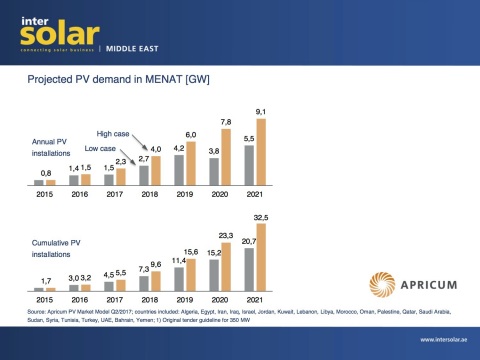MUNICH--(BUSINESS WIRE)--The global PV demand is still dominated by China. EnergyTrend estimates its cumulative installed solar capacity to hit 125 GW by the end of 2017. China, the U.S., India and Japan represent 75% of the world’s entire solar installation capacity for the year 2017. The total global installed PV capacity will exceed 400 GW in 2018, nearly 1 TW total installed solar power is possible by 2021. India alone plans to reach 100 GW of PV by 2022.
Are the GCC ready to join the global solar market leaders?
In 2016, the MENAT countries together only reached a total PV capacity of 3.2 GW, but with an expected installed PV capacity of 32,5 GW by 2022 according to German research company Apricum. This means a tenfold increase, or an annual addition of 6 GW PV.
A number of impressive PV projects have to be implemented to keep up with the global leaders. Saudi Arabia is clearly the next big market. The country keeps its plans for additional 9.5 GW of renewable energy by 2030. Jordan and Egypt are on their path and also getting financial aids from international Banks hoping to complete.
According to former Director of the Fraunhofer Institute for Solar Energy Systems ISE, Prof. Eicke Weber, financing is the biggest challenge in the PV sector, “because there is lots of talk, but the result is a lot of projects are on standby, because of the lack of financial interest. The other problem is that everyone wants to use local production, but it has yet to get going, which slows down the projects”, says Prof. Weber, who will open the second Intersolar Middle East 2017 conference in Dubai.
With more than 80 representatives from Dubai Electricity & Water Authority (DEWA), First Abu Dhabi Bank, Abu Dhabi Water & Electricity Authority (ADWEA), and Bloomberg New Energy Finance, and global players as ABB and Siemens, the Zayed Future Energy Laureate Prof. Weber discusses solutions to get a perceivable and influential part of the global solar share.




